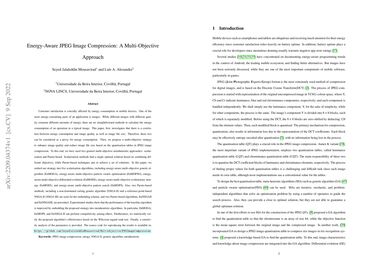Energy-Aware JPEG Image Compression: A Multi-Objective Approach
Customer satisfaction is crucially affected by energy consumption in mobile devices. One of the most energy-consuming parts of an application is images. While different images with different quality consume different amounts of energy, there are no straightforward methods to calculate the energy consumption of an operation in a typical image. This paper, first, investigates that there is a correlation between energy consumption and image quality as well as image file size. Therefore, these two can be considered as a proxy for energy consumption. Then, we propose a multi-objective strategy to enhance image quality and reduce image file size based on the quantisation tables in JPEG image compression. To this end, we have used two general multi-objective metaheuristic approaches: scalarisation and Pareto-based. Scalarisation methods find a single optimal solution based on combining different objectives, while Pareto-based techniques aim to achieve a set of solutions. In this paper, we embed our strategy into five scalarisation algorithms, including energy-aware multi-objective genetic algorithm (EnMOGA), energy-aware multi-objective particle swarm optimisation (EnMOPSO), energy-aware multi-objective differential evolution (EnMODE), energy-aware multi-objective evolutionary strategy (EnMOES), and energy-aware multi-objective pattern search (EnMOPS). Also, two Pareto-based methods, including a non-dominated sorting genetic algorithm (NSGA-II) and a reference-point-based NSGA-II (NSGA-III) are used for the embedding scheme, and two Pareto-based algorithms, EnNSGAII and EnNSGAIII, are presented. Experimental studies show that the performance of the baseline algorithm is improved by embedding the proposed strategy into metaheuristic algorithms.
PDF Abstract
